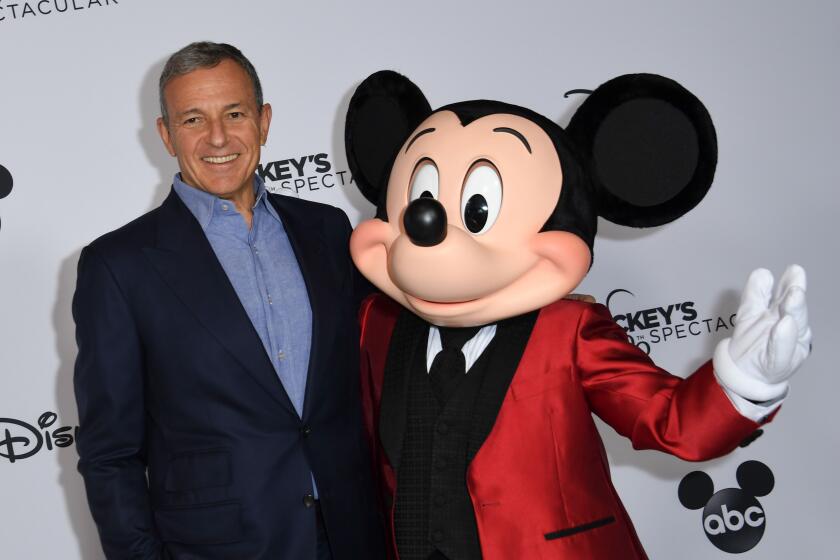LACMA, MOCA fall behind in giving female artists a solo platform
Right now the Los Angeles County Museum of Art and the city’s Museum of Contemporary Art are holding a pair of highly unusual solo exhibitions.
At LACMA, a survey of sculptural environments made since the 1960s by James Turrell to explore human perception has resulted in a show that is on view for more than 10 months — two or three times longer than the typical museum retrospective.
Meanwhile, a mid-career survey of sculpture by Urs Fischer occupies about half of MOCA’s Grand Avenue exhibition space, plus most of the museum’s Geffen warehouse in Little Tokyo — the first time both buildings have been turned over to a living artist since the museum opened a quarter-century ago.
Though the duration and size of these two shows might be extremely unusual, another aspect of them is disappointingly routine: Both artists are men. LACMA and MOCA have recently been giving short shrift to solo exhibitions of art made by women.
FULL COVERAGE: 2013 Spring arts preview
Look at the roster of solo shows on view in the last five years, the period between January 2008 and December 2012. Whether artists of the past or the present; whether full-scale surveys or smaller and more focused projects; whether mostly drawn from the permanent collection or borrowed, they were far more likely to consider male rather than female artists.
Of 68 solos, only 15 went to women.
At MOCA, the rate for women was about 28%. At LACMA, it was just 18%. Both are unsatisfactory.
Those numbers are rather surprising, too, given the two museums’ exhibition histories. MOCA and LACMA are distinctive among their American counterparts in having organized groundbreaking group shows to survey the myriad contributions of women making art.
LACMA’s 2012 “In Wonderland: The Surrealist Adventures of Women Artists in the United States and Mexico” added significant understanding to an essential overview of the field that began in 1976 with the museum’s celebrated “Women Artists: 1550-1950” — the first survey of its kind anywhere. Spurred by the burgeoning feminist art movement of the late 1960s and ‘70s, the show ranks as a landmark in museum scholarship.
A generation after LACMA’s landmark show, MOCA organized a bracing and insightful historical survey, “WACK! Art and the Feminist Revolution” — the first show to fully examine the international foundations and legacy of feminist painting, sculpture, photography, film, video and performance art made between 1965 and 1980. The show filled the Geffen in 2007.
PHOTOS: Arts and culture in pictures by The Times
So the poor numbers for recent solo shows by women at the two museums are difficult to fathom. Yet they are also inescapable.
The discrepancy between them, with MOCA doing slightly better, is no doubt partly a result of the smaller museum’s narrower purview. LACMA includes art made globally since antiquity, but MOCA looks only at art made since the 1940s. Before then, women were more constrained in the opportunity to become artists. There just weren’t as many of them, relatively speaking, as there are now. (Today the majority of MFA students are female.) The modern era began to open doors.
It’s rather surprising therefore to add the Getty Museum’s department of photographs to the numbers mix. Photography is synonymous with the modern area, and most solo shows at the Getty originate in its encyclopedic department of European and American photographs.
Yet from 2008 through 2012, 83% of the solo exhibitions there examined the work of male photographers — slightly more than the number of artists at LACMA.
The scope of the problem becomes stark when you add together LACMA, MOCA and the Getty photo department. In the last five calendar years, four out of five museum solo shows have been by men.
Institutional culture is difficult to change. And don’t underestimate the power of the art market on the museum world, where a profit-motive does not apply (at least theoretically). The market has always favored the investment potential of art made by men, and despite a cataclysmic correction in the early 1990s, the art market is now in full crazy-mode. Prices may be unrelated to quality, but the market erects an expanding platform of visibility that has an indisputable impact.
Still, gender-based inequality is not inevitable in art museums. For proof, look to UCLA. There solo exhibitions shown at the Hammer Museum during those same five years split right down the middle: 50% men, 50% women.
That’s the way it is going forward too. Schedules of upcoming exhibitions are always a work in progress, subject to change and elaboration. As I write, however, the four museums’ websites show the same-old, same-old.
The Hammer has two projects scheduled: one by a woman (Baltimore-born artist Maya Hayuk), one by a man (Egyptian artist Wael Shawky). At LACMA, MOCA and the Getty’s department of photographs, a grand total of 17% of the dozen solo shows, large and small, currently on the docket are by women. By contrast, 83% are by men.
It’s worth noting that, of these four museums, only the Hammer has a woman occupying the director’s office. While there has been a sharp rise in the number of women in curatorial and other administrative positions in art museums, individuals always make the difference. Hammer Director Annie Philbin acts on her egalitarian commitments.
Whatever the explanation, good for the Hammer. And shame on the rest.
More to Read
The biggest entertainment stories
Get our big stories about Hollywood, film, television, music, arts, culture and more right in your inbox as soon as they publish.
You may occasionally receive promotional content from the Los Angeles Times.











